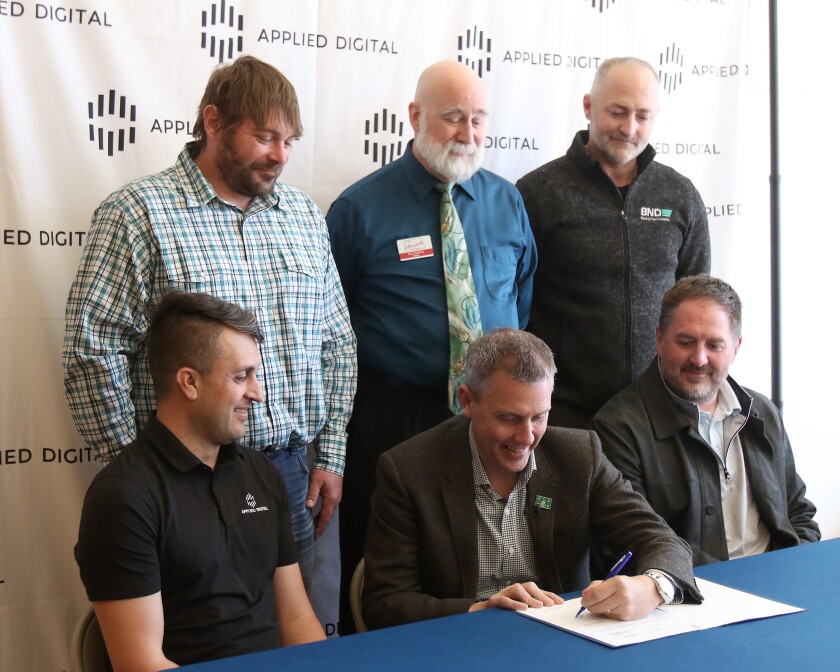North Dakota
New agency poised to tackle ND workforce challenges

BISMARCK — A newly minted state agency is poised to help tackle North Dakota’s workforce shortage even as a promotional campaign that kicked off a little over a year ago continues to make headway.
That’s according to Katie Ralston Howe, director of the Work Force Division of the North Dakota Department of Commerce, who said the first order of business for the Office of Legal Immigration, recently formed by the state legislature, will be to hire a consultant to help develop the scope and goals of the young agency.
Officials who have been dealing with workforce development have been hearing a lot of questions about immigration, according to Howe, who said while officials can speculate on what the opportunities may be in that area, “We want to understand how we best support employers, communities, individuals and families when it comes to navigating the opportunity for bringing in global talent.”
Job Service North Dakota estimates about 40,000 job vacancies exist in the state.
The Office of Legal Immigration, part of the North Dakota Department of Commerce, is legislatively mandated to develop and implement a statewide strategy to support recruitment and retention of foreign labor, including immigrants already in the U.S.
Other things the agency will be tasked with include:
- Advising and making recommendations to the governor, legislative assembly and state agencies regarding immigrant integration and foreign labor issues
- Developing a pilot program that supports businesses pursuing or employing work-authorized immigrants and supporting communities to develop integration plans and activities
- Partnering with other state agencies to develop and administer programs or services related to immigration integration.
While a perception exists among some that government payments made as part of pandemic relief and stimulus were a big part of why some have left the workforce, Howe believes whatever impact such payments may have had is now over.
“I think it (opting out of the workforce) has less to do with choice and comfort and not working and more to do with external factors that are affecting someone’s ability to work,” Howe said, adding that some of those external forces include barriers like child care and transportation.
She said affordable housing is another factor often mentioned when it comes to people who are interested in moving to North Dakota to fill jobs and create a life in the state.
North Dakota’s
Find the Good Life promotional campaign
has been paying dividends when it comes to luring workers to the state. The effort is credited with bringing in 29 workers since it was launched in early 2022, according to Howe.
“That number doesn’t include the number of spouses and children that came with those 29 workers; when we add that in, we’re almost double that number,” Howe said, noting that there are about 2,000 leads in the pipeline regarding possible new workers.
As far as the 29 new workers the state knows about thanks to the Find the Good Life campaign, Howe said it may not seem like a large number considering the number of job openings in North Dakota. But, she added, “You have to start somewhere and we’re making progress.”
Overall, North Dakota has about 3,000 more workers in its workforce than it had a year ago, according to Howe, who said some of those people might have learned about North Dakota through marketing work the Department of Commerce is doing, or they might be students who stayed after graduating from college.
“We’re trying to pin down what’s working the most, so we can double down in those areas,” Howe said.
For more information, visit
commerce.nd.gov/workforce/office-legal-immigration

North Dakota
Protect Medicaid from harmful cuts – a lifeline for North Dakotans

Cuts to Medicaid would have serious consequences for North Dakotans, threatening access to health care and services. This would place additional burdens on families, healthcare providers, and the economy. Currently in ND, the federal government pays 51% of the cost of traditional Medicaid and 90% of the cost of Medicaid Expansion. Therefore, changes in Medicaid could result in fewer services and fewer caregivers.
Medicaid is not just a safety net — it is a pillar of North Dakota’s healthcare system. Beyond providing direct health coverage, Medicaid plays a critical role in supporting hospitals, schools, workforce development, and the financial stability of families.
• 74% of seniors and adults with disabilities are eligible for Medicaid health coverage.
• Medicaid helps sustain North Dakota’s hospital systems and rural health clinics.
• Medicaid provides critical funding for health services in North Dakota schools, covering essential care such as speech.
We strongly urge Congress to reject any proposals that would weaken Medicaid and instead advocate for measures that strengthen this essential program. Cutting Medicaid would not only hurt North Dakota’s most vulnerable residents but would also destabilize our health care system and economy. Our goal through advocacy is to protect Medicaid and consider investing in the value of Medicaid by collaborating with providers to provide high quality care, focus on service delivery strategies that improve outcomes and prioritize reimbursement for higher value services.
The time is now to call and write our congressional representatives. The Capitol switchboard line is (202) 224-3121. Ask for the North Dakota representatives and let them know how Medicaid has helped you or your loved one.
This letter is on behalf of the North Dakota Disabilities Advocacy Consortium Board of Directors.
North Dakota
Armstrong issues first veto as North Dakota governor

BISMARCK — North Dakota Gov. Kelly Armstrong issued his first veto since assuming office Friday, citing concerns over the constitutionality of Senate Bill 2261.
The legislation sought to establish a prison industries workforce development tax credit — a non-refundable tax credit equal to 10% of the cost of purchased components of final manufactured products or labor from prison industries.
In his statement on the veto, Armstrong said the credit would have potentially created an incentive to purchase components from Rough Rider Industries – a self-sustaining state agency at the State Penitentiary which qualifies as a prison industry providing final manufactured products.
He said the bill creates an “uneven playing field” by giving Rough Rider Industries an unfair competitive advantage over out-of-state manufacturers. That would potentially violate the Dormant Commerce Clause of the U.S. Constitution, which prohibits states from enacting laws that discriminate against or unduly burden interstate commerce.
“Tax credits, when given to micro-segments of the economy, decrease state revenue and further saddle those still paying taxes with a higher percentage of the tax burden,” Armstrong said in his statement. “Any tax policy that creates this type of carve-out must be tied to a significant outcome that benefits the state’s economic interests. This bill does not do that. Combined with the aforementioned legal concerns, the juice in this case is quite simply not worth the squeeze.”
North Dakota Office of the Governor
The bill passed the Senate in a 43-3 vote and passed the House of Representatives on a 56-33 vote.
To override the veto, both chambers of the Legislature vote and both need to reach a two-thirds majority in favor of the override. A two-thirds majority is 63 votes for the House and 32 votes for the Senate.
North Dakota
Applied Digital plans to expand in Ellendale, ND

ELLENDALE, N.D. — Applied Digital Corp. plans to expand its footprint in Ellendale, North Dakota, according to Nick Phillips, executive vice president of public affairs and real estate acquisitions for the company.
Applied Digital completed a blockchain facility in Ellendale in 2023, and its current 380,000-square-foot, high-performance computing facility is expected to begin operations later this year. That will be followed by two additional 900,000-square-foot expansions, Phillips said.
John M. Steiner / The Jamestown Sun
“The first building that’s going up right now is about a $1.3 billion investment for us, and we’re anticipating another $4 billion,” he said. “That’s our investment for the buildings, the transformers, the chillers, all of the mechanical equipment. We anticipate our customer will invest approximately another $15 billion, so this is about a $20 billion total capital investment on our 320-acre site.”
Applied Digital hosted Gov. Kelly Armstrong and officials from the state, the City of Ellendale and Dickey County on Wednesday, March 19, to learn about the company’s operations in North Dakota. The event included a tour of Applied Digital’s data center, which is currently under construction, and Ellendale Acres.

John M. Steiner / The Jamestown Sun
Ellendale Acres is a housing community that was developed with a partnership between Applied Digital, the City of Ellendale, the state of North Dakota and Headwaters Development to build 20 homes and a 38-unit apartment complex.
Armstrong also signed House Bill 1539 at the event in Ellendale. With the signing of HB 1539, on-site backup electric generation that exceeds 50 megawatts and is not connected to the power grid will no longer be subject to the North Dakota Public Service Commission’s Siting Act, according to a news release from the Office of the Governor. The change in law takes effect Aug. 1.

John M. Steiner / The Jamestown Sun
“This will allow data centers and other businesses to add on-site backup generation more easily with local approval while still complying with environmental protections,” the news release says. “In testimony on the bill, Applied Digital, which also has a facility in Jamestown, said backup power generation will protect workers and equipment from unintentional harm caused by unexpected disconnection from the power grid and will allow the data center’s large load to operate off-grid in emergency situations, improving the reliability of the grid for other customers and the grid’s operators.”
Applied Digital designs, develops and operates next-generation data centers across North America to provide digital infrastructure solutions to the high-performance computing industry, Phillips said.
In North Dakota, Applied Digital has blockchain sites that support cryptocurrency mining about 7 miles north of Jamestown and 1 mile west of Ellendale.

John M. Steiner / The Jamestown Sun
Armstrong told The Jamestown Sun that Applied Digital’s project in Ellendale can happen in North Dakota because of the state’s great fiber buildout, business environment and energy.
“When you have a town like Ellendale in this area of rural North Dakota that has really been struggling just to stay alive for the last 20 years, it’s a tremendous opportunity not just for this community but for the economy of south-central North Dakota,” he said.
Ellendale Mayor Don Flaherty said Applied Digital gives the City of Ellendale an ability to move forward and do things for the community that weren’t possible five to 10 years ago.

John M. Steiner / The Jamestown Sun
“Now I can stand in front of you today and I can say with the things that are happening right now, I see Ellendale being a shining light in this area of North Dakota well into the 22nd century because of the things that we’re going to do and the strength that we’re going to bring back to our community because of this,” he said.
Phillips said Applied Digital expects to be a top 10 property taxpayer in the state in the next year or two.
Ellendale Acres partnership
Applied Digital expects to employ 350 full-time employees at the Ellendale site, and those people will need places to live in the community, Phillips said.
“In terms of local infrastructure, one of the things that we’ve needed to do is we’re trying to convince folks to move here, to live here in Ellendale, and that’s very important for us,” he said.

John M. Steiner / The Jamestown Sun
Currently, about 450 workers are in Ellendale for construction of the 380,000-square-foot, high-performance computing artificial intelligence data center, Phillips said.
“I’m told that number (of workers) is going to go up drastically as the next two buildings get farther underway,” he said.
Flaherty said Ellendale’s peak population was either 1,800 in the late 1950s or early ’60s or 1,500 in 2000, depending on what artificial intelligence Google search engine was used. Ellendale’s current population is over 1,100, according to the U.S. Census Bureau.
Flaherty said Applied Digital coming to Ellendale is the “first domino to fall.” As a result, he said more people will want to do business in Ellendale.

John M. Steiner / The Jamestown Sun
“We’re going to have spouses of people who are going to work at the data center who are going to say, ‘Hey, I want to start this kind of business,’ or ‘I’ve had this kind of experience and I want to bring that to here,’ ” he said.
To help the Ellendale community, Applied Digital partnered with Headwaters Development and the Bank of North Dakota to build 20 new homes — eight four-bedroom and 12 two-bedroom — and a 38-unit apartment complex utilizing the state’s Rural-Workforce Initiative to Support Housing (R-WISH) pilot program. The housing development is called Ellendale Acres and is located in south Ellendale.
The R-WISH pilot program utilizes up to $10 million of Bank of North Dakota capital to complement the work done by the North Dakota Housing Finance Agency and the North Dakota Housing Initiative Advisory Committee, according to Bank of North Dakota’s website. The maximum amount from the R-WISH fund is the lesser of 30% of the project costs, $3.5 million or the matching contribution from the company.
Applied Digital contributed $3.5 million toward the program to build housing in Ellendale. Headwaters Development will own the homes and apartment complex and rent them to Applied Digital employees.

John M. Steiner / The Jamestown Sun
Armstrong said Applied Digital’s project and helping with Ellendale’s housing challenge is a holistic view of economic development. He said a local community and its elected officials need to promote and welcome business.
“You need a company that wants to be there,” he said. “You get private equity and then you get the Bank of North Dakota to step in. It really is kind of an all-above approach. They (Applied Digital) can’t build that facility if anybody who works there has nowhere to live. So they’ve engaged in the community in a really meaningful way. I think it’s a model for how you would do a large-scale project in a place like Ellendale.”
Ryan Sailer, president of Headwaters Development, said Ellendale Acres is a big accomplishment that had great collaboration to make it happen. He talked about the challenges and hurdles to bring housing to rural communities.
He said construction costs have increased for housing in rural communities. He also said it’s difficult for rural communities to get contractors and subcontractors to build housing the magnitude of Ellendale Acres.
He said the rental prices are lower in rural areas compared to urban areas, which caps the mortgages.
“As developers, we’re bringing in more equity which often isn’t sustainable because we have investors that require a certain risk-adjusted rate of return, and they’re not willing to take the risk,” he said.
He said if employers want to expand or a city wants to bring in employers, housing is needed for their employees.
“You almost have to come up with a combined solution to figure out how to do it somewhat all at once, to make it sustainable and viable,” he said.
Armstrong said Senate Bill 2225, which establishes the Housing for Opportunity, Mobility and Empowerment (HOME) grant program in the North Dakota Department of Commerce, is a complementary program to the R-WISH pilot program.
“Not every community that has a housing need has an Applied Digital coming in,” he said. “The R-Wish program only works because Applied Digital has bought in, the financing guys, Headwaters has bought in, and the bank (Bank of North Dakota) has bought in. There are places across North Dakota whether it’s Richardton or Hillsboro and between that also need housing that don’t have something like this (Applied Digital) at scale.”
If SB 2225 is approved, the Commerce Department would award grants to political subdivisions to build infrastructure to support affordable market-rate housing. The grant program would be funded one time and ends on June 30, 2027.
SB 2225 would appropriate $50 million to the program. The Commerce Department would allocate $10 million for communities with a population of 5,000 or less, $20 million for communities with a population of 5,001 to 20,000 and $5 million for rural metropolitan areas located within 20 miles of city limits of a community with more than 20,000 people.
The program provides grant dollars for one-third of the infrastructure costs for residential development projects. The local political subdivision and the developer of the residential lots would each provide one-third of the costs for residential development projects.
-

 Midwest1 week ago
Midwest1 week agoOhio college 'illegally forcing students' to share bathrooms with opposite sex: watchdog
-

 News1 week ago
News1 week agoJudges threatened with impeachment, bombs for ruling against Trump agenda
-

 News1 week ago
News1 week agoVideo: Researchers Find Shipwreck Lost Since 1892
-

 World1 week ago
World1 week agoRussia, China call on US to drop Iran sanctions, restart nuclear talks
-

 Politics1 week ago
Politics1 week agoBarely: House GOP passes government funding bill without help from Democrats
-

 Politics1 week ago
Politics1 week agoAll illegal migrants held in Guantanamo Bay, Cuba have been sent to Louisiana
-

 News1 week ago
News1 week agoFor Canadians Visiting Myrtle Beach, Trump Policies Make the Vibe Chillier
-

 News1 week ago
News1 week agoArlington National Cemetery stops highlighting some historical figures on its website

















